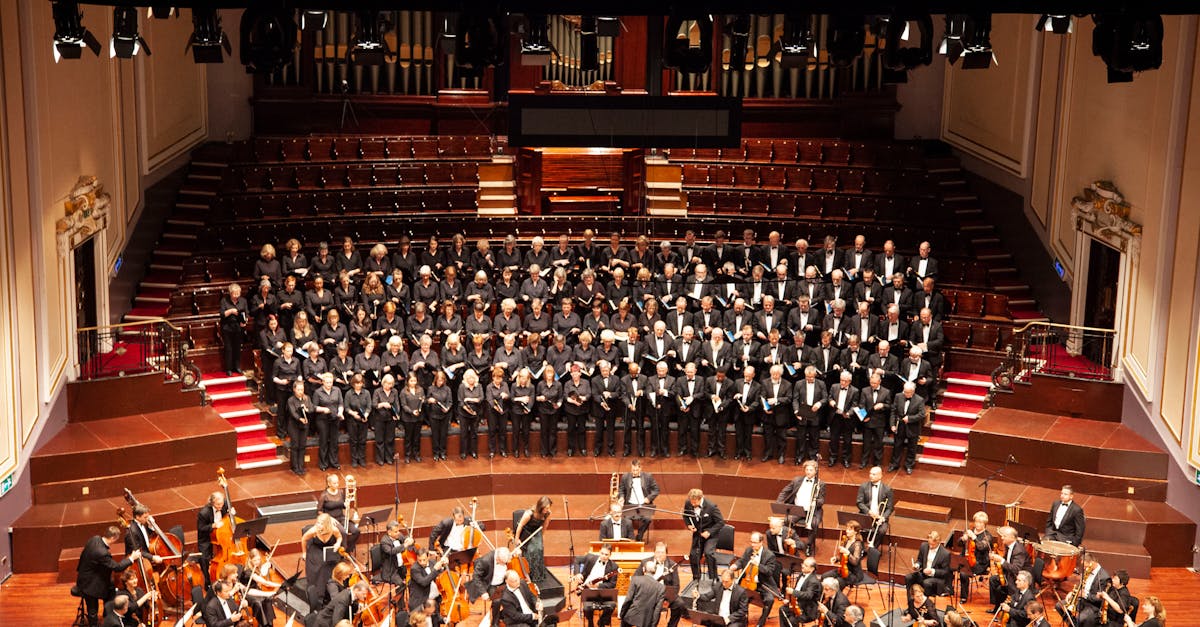Discovering the Harmonic World of Symphony Music
Introduction
The world of symphonies stands as a testament to the rich tapestry of human creativity and cultural expression. At its core, a symphony is an extended musical composition often performed by a full orchestra. These pieces have captured the imaginations of audiences, drawing listeners into a world where melody, harmony, and rhythm intertwine to evoke powerful emotions. Historically, symphonies have paved the way for the evolution of orchestral music, offering composers a medium to experiment and innovate. With its roots stretching back centuries, the symphony continues to be a dynamic force in contemporary arts and entertainment. But what makes the symphony such a lasting phenomenon in our cultural heritage?
Advertisement
Origins of the Symphony
The symphony's lineage can be traced back to the late Baroque period, around the early 18th century. Emerging from Italy, it evolved from the overtures of operatic performances, known as 'sinfonias'. Composers like Giovanni Battista Sammartini laid the groundwork for what would become a defining compositional form. As the Baroque era gave way to the Classical era, the symphony transformed, with composers such as Haydn and Mozart refining its structure. Their work established a four-movement format that typically began with a fast-paced opening, followed by a more subdued second movement, a minuet or scherzo third movement, and a rousing finale. This period marked the symphony's ascent as a central pillar of concert music.
Advertisement
The Romantic Symphony Expansion
The Romantic era, spanning the 19th century, saw the symphony take on a new dimension. Inspired by heightened emotional expression and larger-than-life narratives, composers like Beethoven, Brahms, and Tchaikovsky expanded both the scope and scale of the symphony. Orchestral size increased, harmonies became richer, and thematic material was explored more deeply. Beethoven’s Symphony No. 9 with its choral finale, for instance, broke new ground by integrating voices into the symphonic form. These innovations ushered in an era where the symphony could convey the full range of human experience, from the deeply personal to the transcendent.
Advertisement
Modern Symphonic Innovations
Moving into the 20th century, the symphony continued its evolution, adapting to shifts in musical aesthetics and cultural changes. Composers like Shostakovich and Mahler brought new narrative complexities and emotional depth, often reflecting the tumultuous geopolitical landscapes surrounding them. Meanwhile, figures like Stravinsky and Schoenberg experimented with tonality and atonality, pushing symphonic music into avant-garde territories. Today, contemporary composers continue to explore new dimensions of the symphony, infusing it with modern elements and technology, thereby keeping this venerable form both relevant and innovative.
Advertisement
The Role of Conductors
Orchestral symphonies are not just about the composers and musicians; conductors play a pivotal role in bringing a symphonic score to life. Tasked with interpreting the composer’s intent, conductors shape the emotional and dynamic qualities of each performance. Through their unique interpretations, conductors like Leonard Bernstein, Herbert von Karajan, and Gustavo Dudamel have left indelible marks on the symphonic landscape. Their vision can elevate the music, adding fresh perspectives and creating memorable, sometimes legendary, performances that resonate with audiences.
Advertisement
Symphonic Orchestras: Pillars of Culture
Symphony orchestras are cultural beacons, showcasing the artistry and musical traditions of their regions. Ensembles like the Vienna Philharmonic, Berlin Philharmonic, and New York Philharmonic have become synonymous with excellence in symphonic music. By performing both classic repertoire and contemporary compositions, these orchestras not only preserve but actively contribute to the evolution of the symphonic genre. Their global tours and recordings help bring symphonic music to diverse audiences, introducing new generations to the beauty of orchestral performance.
Advertisement
Impact on Modern Entertainment
Beyond concert halls, the influence of symphony extends into other spheres of arts and entertainment. Symphonic music has found a home in cinematic scores, with composers like John Williams and Hans Zimmer drawing heavily from its rich traditions. These scores have become integral to the storytelling of films, capturing nuances of emotion and drama. Moreover, symphonic concerts often collaborate with other art forms, such as ballet and opera, showcasing the versatility and adaptability of the symphonic form. With technology making symphonic music more accessible, its reach continues to grow, making it a formidable force in modern entertainment.
Advertisement
Promoting New Symphonic Works
Today, promoting and supporting new symphonic compositions is crucial for perpetuating the genre’s vitality. Organizations and competitions encourage and commission works by contemporary composers, providing them with platforms to present fresh voices and ideas. By integrating diverse musical styles and influences, new symphonic music reflects our current world, ensuring the form's ongoing relevance. Innovators in the field experiment with unconventional structures, tonal palettes, and thematic explorations, thus expanding the boundaries of what a symphony can be in today's global soundscape.
Advertisement
Challenges of the Symphony
Despite its grandeur, the symphony faces challenges in engaging new audiences amid an ever-changing cultural landscape. The perception of symphonic music as elitist or outdated can deter younger audiences. Efforts to make symphony concerts more inclusive and accessible include educational outreach, virtual performances, and collaborations with popular music artists. By championing cultural diversity and innovation within symphonic programming, orchestras aim to attract a broader audience, ensuring that this prestigious art form remains dynamic and integral.
Advertisement
Conclusion
The symphony remains a vital and dynamic component of the arts and entertainment landscape. By transcending time and cultural boundaries, symphonic music continues to captivate audiences, offering them a melodic narrative of human emotion. From its historic roots in the Baroque and Classical eras, through the emotive expanse of the Romantic period, to modern innovations, the symphony embodies the essence of musical evolution. As we look to the future, it is evident that the symphony will continue to evolve, touching the hearts and minds of audiences worldwide. By appreciating its history and embracing its modern transformations, we ensure that the symphonic tradition remains a vibrant and enduring facet of artistic expression.
Advertisement


